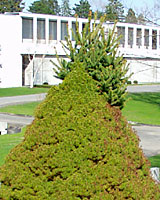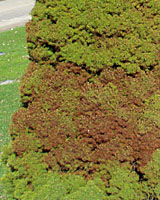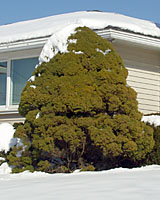Terry L. Ettinger Horticulture Consulting Services
Meeting The Needs Of Today With A Vision For The Future
Question of the Week
Weird Alberta Spruce Growth
 Q. We've planted five dwarf Alberta spruces in our landscape since building our home twenty years ago. A couple
of years ago, it looked as though a new evergreen tree with much larger stems and needles was growing out through the top
of the oldest one. We looked closer and were amazed that the growth was actually part of the original dwarf tree! What's
going on here - and will whatever it is spread to our other trees?
Q. We've planted five dwarf Alberta spruces in our landscape since building our home twenty years ago. A couple
of years ago, it looked as though a new evergreen tree with much larger stems and needles was growing out through the top
of the oldest one. We looked closer and were amazed that the growth was actually part of the original dwarf tree! What's
going on here - and will whatever it is spread to our other trees?
A. As I've written previously in this column, Dwarf Alberta spruce (Picea glauca 'Conica'), is a small. though not exactly "dwarf" cultivar (i.e., "cultivated variety") of white spruce.
What you're seeing is a stem that's "reverted" to the normal growth pattern of white spruce - one-half to three-quarter inch-long needles borne singly on stems that grow four to eight inches per year. It's a relatively common occurrence - maybe five or ten out of every hundred Alberta spruce are affected, but doesn't actually spread from one plant to another.
You can simply cut the reverted stem out of the affected plant at its point of origin. However, if the reversion has grown quite large, you might be left with a large gap that will take many years to close. Therefore, it's always best to remove reversions as soon as they're noticed.
Meanwhile, a couple of additional thoughts regarding Alberta spruce.
 First, don't be surprised if many of the needles on your spruce turn reddish-brown - especially
on the northwest and south sides of your plants over the winter. This is a very common phenomenon referred
to as "winter dessication." Affected needles are simply dried out by bitter cold
temperatures. Once new growth emerges in mid- to late May, you'll no longer notice the damage.
First, don't be surprised if many of the needles on your spruce turn reddish-brown - especially
on the northwest and south sides of your plants over the winter. This is a very common phenomenon referred
to as "winter dessication." Affected needles are simply dried out by bitter cold
temperatures. Once new growth emerges in mid- to late May, you'll no longer notice the damage.
 Second, as I mentioned above, Alberta spruce are not "dwarf" plants! Over twenty to thirty years, it's
not unusual for them to grow at least ten to fifteen feet tall and six to ten feet wide. So please, don't plant them
too close to the foundation of your home, a sidewalk, patio, cemetery headstone, etc!
Second, as I mentioned above, Alberta spruce are not "dwarf" plants! Over twenty to thirty years, it's
not unusual for them to grow at least ten to fifteen feet tall and six to ten feet wide. So please, don't plant them
too close to the foundation of your home, a sidewalk, patio, cemetery headstone, etc!